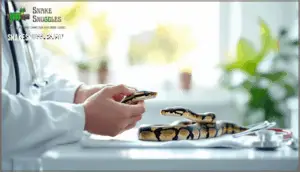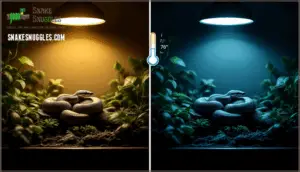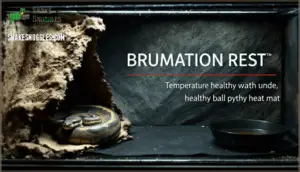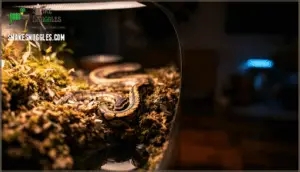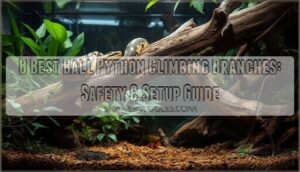This site is supported by our readers. We may earn a commission, at no cost to you, if you purchase through links.
 A ball python curled up, eyes alert and body still, isn’t lazy—it’s listening to instincts older than the pyramids. Even in warm living rooms, these snakes will sometimes slow down, eat less, and hide away, echoing ancient rhythms shaped by sun and season.
A ball python curled up, eyes alert and body still, isn’t lazy—it’s listening to instincts older than the pyramids. Even in warm living rooms, these snakes will sometimes slow down, eat less, and hide away, echoing ancient rhythms shaped by sun and season.
Understanding ball python brumation isn’t just about keeping your pet healthy; it’s about reading the subtle cues nature programmed into every scale and flicker of their tongue. If you want your ball python to thrive, it pays to follow their lead and get brumation care right from the start.
Table Of Contents
- Key Takeaways
- What is Ball Python Brumation?
- Which Reptiles Brumate?
- Why Do Ball Pythons Brumate?
- How to Prepare for Ball Python Brumation
- Signs Your Ball Python is Brumating
- Caring for Your Ball Python During Brumation
- Managing The Brumation Timeline
- Health Risks and When to Seek Help
- Expert Tips for Successful Brumation
- Frequently Asked Questions (FAQs)
- Do ball pythons brumate?
- Do pythons need brumation?
- How long should a ball python brumation period last?
- How to breed ball pythons?
- Are ball pythons easy to care for?
- How do you care for a ball python?
- How long do ball pythons brumate?
- Should I feed my snake during brumation?
- What to do during snake brumation?
- What temperature do you Brumate snakes?
- Conclusion
Key Takeaways
- Ball pythons sometimes enter a slow, low-activity state in response to cooler temperatures or less food, but true brumation is rare in captivity if consistent conditions are maintained.
- Preparing your snake for brumation means checking its health, emptying its digestive system, and gradually lowering temperature and light to avoid stress.
- During brumation, you should provide fresh water, monitor temperature and humidity, minimize handling, and track weight to catch health issues early.
- Signs of brumation include reduced activity, less eating, and extra hiding, and the brumation period typically lasts four to eight weeks depending on environment and individual factors.
What is Ball Python Brumation?
Ball pythons don’t truly brumate the way many other reptiles do, but they can enter a similar slowdown during cooler months. Understanding what brumation means—and how it differs from what your ball python experiences—helps you recognize normal seasonal behavior and avoid unnecessary worry.
Let’s break down the basics so you know what to expect.
Definition and Natural Purpose
Brumation is a reptile’s way of hitting pause on life—a state of dormancy triggered by cooler temperatures and shorter days that allows ball pythons to conserve energy when environmental conditions become less favorable.
In the wild, this survival strategy helps your snake weather periods when prey becomes scarce and temperatures drop.
It’s an evolutionary advantage hardwired into reptile behavior, part of their natural cycle that synchronizes their metabolic needs with seasonal changes.
Brumation Vs. Hibernation
While people often use the terms interchangeably, brumation and hibernation aren’t quite the same thing—and understanding the difference helps you care for your ball python properly. Here’s what sets them apart:
- Physiological Differences: Hibernation involves true sleep in mammals, while brumation allows reptiles to remain partially alert and occasionally move for water.
- Metabolic Rates: Both slow metabolism, but hibernating mammals drop body temperature dramatically, whereas brumating snakes adjust to ambient temperature changes.
- Environmental Triggers: Reptile brumation responds directly to external temperature shifts, while mammal hibernation follows internal biological clocks.
Brumation in Wild Vs. Captive Ball Pythons
Once you understand how brumation works, you’ll notice it plays out differently in natural versus controlled settings. In the wild, ball pythons respond to dramatic seasonal shifts—dropping temperatures and prey scarcity in West and Central Africa trigger dormancy as a survival mechanism. Your captive snake, however, lives in a stable environment where you control temperature, humidity, and food availability. That means brumation isn’t automatic—it depends on whether you simulate those seasonal cues or maintain constant conditions year-round. Reptiles undergo a natural dormancy period known as brumation, similar to hibernation in mammals.
| Aspect | Wild Ball Pythons | Captive Ball Pythons |
|---|---|---|
| Brumation Triggers | Natural temperature drops, reduced prey | Owner-controlled environmental changes |
| Dietary Impact | Limited food forces energy conservation | Consistent feeding may prevent brumation |
| Duration | Follows regional seasonal patterns | Variable; depends on keeper’s setup |
| Environmental Control | No control over ambient conditions | Full temperature and lighting regulation |
| Necessity | Essential for survival and reproduction | Optional; many thrive without it |
Which Reptiles Brumate?
Brumation isn’t exclusive to ball pythons—it’s a survival strategy shared across many reptile species. However, not all reptiles brumate the same way, and understanding these differences helps you care for your snake properly.
Let’s look at which reptiles undergo this dormancy period and what makes ball pythons unique.
Common Reptile Species That Brumate
Many reptiles—from snakes and lizards to turtles and tortoises—undergo brumation when temperatures drop and food becomes scarce. Brumation factors include temperature shifts, daylight changes, and prey availability, triggering this natural dormancy across reptile groups.
Common examples include box turtles, bearded dragons, and various gecko species. Snakes like garter snakes, rattlesnakes, and hognoses routinely brumate in response to seasonal cues.
Differences Among Snake Species
Over 3,000 snake species display diverse brumation patterns shaped by climate influence and geographic location. Northern gartersnakes may brumate for six months, while desert snakes often skip it entirely. Timber rattlesnakes exhibit both communal and solitary brumation depending on den availability. Ball pythons usually brumate alone for shorter periods—6 to 12 weeks—responding more to resource shifts than cold.
These physiological changes reflect each reptile’s adaptation to its native habitat. Snakes enter a state called brumation instead of hibernation.
Unique Aspects of Ball Python Brumation
Ball pythons stand apart from most brumating snakes because they respond less to temperature drops and more to shifts in prey availability and breeding cycles. In captivity, differences become obvious—many ball pythons won’t brumate at all if you maintain stable temperature and feeding schedules.
Individual variation matters too. Genetic factors influence whether your snake enters brumation, along with behavioral changes tied to age and health. Some ball pythons slow down briefly, while others skip it entirely, making reptile care highly individualized.
Why Do Ball Pythons Brumate?
Ball pythons don’t brumate on a whim—they respond to specific triggers that signal it’s time to slow down. In their natural habitat, shifting temperatures and shorter days tell them winter is coming.
Understanding these triggers helps you provide the right conditions and recognize why your snake enters this dormant state.
Temperature and Seasonal Cues
In their West and Central African homeland, ball pythons don’t check calendars—they read the subtle shift in temperature and daylight that signals the dry season’s approach. When nighttime temperatures drop and humidity declines, your snake’s internal clock responds.
In captivity, ball pythons may enter brumation if their temperature gradient isn’t maintained properly. Environmental control prevents unwanted reptile brumation, keeping your snake active year-round unless you’re intentionally supporting this natural hibernation-like state.
Energy Conservation and Survival
When prey becomes scarce and temperatures plummet, your ball python’s body switches into survival mode—slowing its metabolism to a crawl and living off stored fat reserves. This ectothermic adaptation lets your snake weather harsh conditions without feeding for weeks or months. During this dormancy period, four critical changes occur:
- Metabolic rate drops by 70-80%
- Heart rate and breathing slow dramatically
- Digestive processes halt completely
- Stored energy from fat sustains life functions
Environmental adaptation through brumation makes certain your snake survives when limited resources make hunting impossible.
Reproductive Cycle Synchronization
Brumation acts like nature’s calendar for breeding season—synchronized cooling periods trigger hormonal changes in both male and female ball pythons, aligning their reproductive readiness. This cooling cycle stimulates testosterone in males and follicle development in females, making mating happen when conditions support clutch viability.
Without this temperature drop, breeding seasonality becomes erratic, potentially compromising hatchling health and genetic diversity. Your captive breeding program benefits from mimicking these natural reptile breeding and reproduction patterns, timing the brumation phase so eggs develop properly during incubation.
How to Prepare for Ball Python Brumation
Getting your ball python ready for brumation takes planning and patience. You can’t just drop the temperature overnight and expect everything to go smoothly.
The key is taking it step by step, starting with a thorough health check and working your way through each stage of preparation.
Pre-Brumation Health Checks
Before your ball python enters dormancy, you’ll want to confirm it’s in peak condition—think of this as a pre-flight checklist where any underlying issue could turn serious during the months of reduced activity ahead.
Schedule a veterinarian visit for parasite screening and body condition assessment. Check scale health, hydration levels, and make certain your snake completed its most recent shedding cycle without complications before brumation begins.
Digestive System Preparation
Once your snake gets the all-clear from the vet, your next job is to make sure its digestive tract is completely empty—leaving undigested food inside during dormancy can lead to dangerous bacterial growth or even organ damage. Stop feeding your ball python three to four weeks before brumation begins, allowing its slowed metabolic rate to process the final meal completely.
Monitor for normal bowel movements and consider a fecal exam to rule out parasites that could complicate dormancy. Clearing the gut prevents impaction risks while keeping fresh water available aids hydration throughout this fasting period.
Gradual Temperature and Lighting Reduction
After your python’s digestive system is clear and ready, you’ll need to slowly dial down the heat and light to mimic the cooler, shorter days of winter. Simulating seasonal change takes patience—drop your thermostat by 3-5°F each week until you reach the target brumation range of 65-72°F, while gradually reducing your basking light exposure. This controlled temperature reduction prevents shock and allows your reptile’s metabolism to adjust naturally.
- Week-by-week dimming schedule: Reduce photoperiod from 12 hours to 8 hours over three weeks, allowing your ball python to sense approaching dormancy.
- Thermostat calibration: Verify your temperature control equipment with a reliable thermometer to avoid dangerous fluctuations during brumation.
- Humidity adjustments: Maintain 50-60% humidity throughout temperature reduction to prevent respiratory issues as conditions change.
Creating a Brumation Environment
With your temperature and light dialed back, it’s time to set up a safe, quiet space where your python can settle in for the next few months. Choose a cooling chamber or brumation enclosure that’s appropriately sized—not too large, which can stress your ball python.
Add clean substrate like paper towels for easy monitoring, maintain humidity control at 50-60%, and install reliable monitoring equipment to track temperature fluctuations throughout the brumation period.
Signs Your Ball Python is Brumating
Once you know what to expect, spotting brumation becomes much easier. Your ball python will show clear behavioral changes that signal it’s entering this dormant phase. Watch for these three telltale signs that brumation has begun.
Reduced Activity and Appetite
Ever wondered why your usually curious python suddenly seems content to lounge in one spot and skip meals for weeks on end? During brumation, it’s normal for Ball Pythons to show:
- Longer hiding beneath cover
- Noticeable Appetite Decline or outright anorexia
- Less movement—true Brumation Sluggishness
- A preference for cooler spots, responding to lower Temperature
These changes reflect natural Lethargy Causes.
Lethargy and Sleep Patterns
How often have you peeked into your python’s enclosure, only to find them dozing off for hours without a care in the world? This sluggish behavior, marked by extra-long sleep duration and clear activity reduction, is one of the earliest brumation signs in Ball Pythons.
Lethargy isn’t a cause for worry—it’s how your snake deals with hibernation-like changes.
Changes in Hiding and Behavior
Maybe it’s the drop in temperature or just brumation instincts kicking in, but these activity shifts are normal. Increased hiding and erratic behavior—like unusually long sleep duration or avoiding social contact—are classic signs.
Ball pythons may retreat for days, resurfacing briefly before vanishing again. Such animal behavior helps your snake conserve energy until warmer months return.
Caring for Your Ball Python During Brumation
When your ball python enters brumation, its needs shift in a few important ways. You’ll want to focus on the basics to keep it healthy and comfortable.
Here’s what you should pay attention to during this quieter season.
Maintaining Proper Temperature and Humidity
Keeping your reptile’s environment comfortable is a bit like tuning a favorite radio—get the setting just right, and everything runs smooth.
Here are the key steps to ensure your Ball Python’s habitat is optimal:
- Use Temperature gradients across your Ball Python’s enclosure for proper brumation.
- Add humidity sources, like damp moss, to support hydration.
- Rely on Monitoring tools to check temperature and humidity.
- Match Enclosure size to the snake.
- Make seasonal adjustments as needed.
Providing Fresh Water and Minimal Handling
A steady supply of fresh water does more for your brumating ball python than you might think, offering comfort and support when the world slows down. Keep the water bowl clean and accessible—hydration monitoring is vital, even if the snake barely moves. Minimal contact is best avoided; aim for minimal disturbance. Less contact means less stress for your reptile during brumation.
| Water Bowl Hygiene | Hydration Monitoring | Gentle Handling |
|---|---|---|
| Change water daily | Check bowl is full | Avoid picking up snake |
| Scrub to prevent algae | Look for dehydration | Observe, don’t touch |
| Use shallow bowl | Refresh after spills | Calm environment |
| Clean with safe soaps | Spot-check weekly | Less stress, better rest |
Monitoring Weight and Health
Think of regular weigh-ins as your ball python’s way of leaving breadcrumbs along the brumation trail—each one helps you spot trouble before it finds you. Track these key signs:
- Weight Loss: Keep tabs every 1-2 weeks for drastic drops.
- Hydration Levels & Skin Condition: Check for wrinkling or dryness.
- Behavior Changes: Lethargy or refusal to drink? Consult a reptile veterinarian quickly.
Managing The Brumation Timeline
Managing your ball python’s brumation means paying attention to timing, temperature, and subtle changes in behavior. You’ll want to know what to expect along the way.
Here’s what to keep in mind as you set up their space.
Typical Duration for Ball Pythons
Most ball pythons settle into brumation for just a few weeks to a couple of months, slipping quietly into their winter slowdown much like clockwork. The ideal length of the brumation period falls well short of the deep hibernation period seen in other species.
In captivity, temperature and health impacts tend to shorten brumation, supporting quick post-brumation recovery.
Factors Affecting Brumation Length
Your ball python’s brumation length doesn’t follow the exact script every year. Subtle shifts in age factors and overall health status can swing the timeline, as can hydration levels or wild versus captive environments.
Watch for:
- Fluctuating temperature or daylight cues
- Shifts in metabolic rate with age
- Stresses on reptile health, like sudden humidity drops
Signs Brumation is Ending
Look for increased activity—your snake may roam the enclosure or show curiosity after weeks of rest. A renewed feeding response is a strong clue, too; if it sniffs around for food, brumation is easing up.
Some ball pythons shed once temperatures rise. Normal behavior and gradual weight gain confirm things are on track; keep your veterinarian’s contact handy.
Health Risks and When to Seek Help
Brumation doesn’t come without risks, and it’s important to know what warning signs to watch for in your ball python. Here’s what you need to look out for as you monitor your snake.
In the next section, you’ll find the most common health concerns that can pop up during this time.
Dehydration and Excessive Weight Loss
If your ball python starts to look thin or its skin seems loose during brumation, that’s your cue to pay close attention. Recognizing dehydration and weight loss early is key.
Monitor hydration by checking for skin elasticity and using a digital scale. If you notice steady weight loss, intervene with fresh water and consult your vet.
Prioritize post-brumation care for healthy recovery.
Respiratory and Skin Issues
Sometimes, snake health concerns show up quietly—think BPNV infections, breathing trouble, or fungal dermatosis flaring after brumation. Environmental factors like low humidity set the stage, especially if your ball python’s skin looks patchy or you’re seeing mucus at the mouth.
Diagnostic methods often rely on post-brumation shedding for clues, helping your veterinarian catch problems before they spiral.
When to Consult a Reptile Veterinarian
Even if you’re experienced, it’s wise to lean on veterinary medicine when unexplained symptoms pop up—think sudden weight loss, difficulty breathing, or sores that won’t heal. Emergency situations rarely announce themselves.
Prioritizing preventative care or scheduling a post-brumation checkup helps catch ball python brumation complications early, safeguarding your snake’s health and the foundation of reptile health and wellness.
Expert Tips for Successful Brumation
Setting your snake up for brumation takes a little extra planning and awareness. There are a few key things you can do to give your ball python a smooth experience.
Here’s what to look for as you prepare their enclosure.
Patience and Careful Monitoring
It’s remarkable how much smoother brumation goes when you slow down, watch closely, and let your python set the pace. This isn’t just about waiting it out—patience means attentive care rooted in real observation and trust. Make each week count with small, steady routines:
Brumation goes best when you slow down, observe, and trust your python to set the rhythm for each week
- Observe Behavior daily for natural changes.
- Track weight with a digital scale.
- Check hydration quietly.
- Avoid unnecessary contact—minimal disturbances matter.
- Adjust temperature with gradual changes to support healthy brumation and hibernation habits.
Post-Brumation Recovery Steps
After weeks of winding down, your python’s first stretch back into activity signals it’s time to help them gently wake up and readjust. Start with a careful re-feeding schedule—offering small meals and watching for proper digestion. Prioritize hydration—always keep fresh water within reach.
Support shedding by boosting humidity. Fine-tune your enclosure adjustments to match warmer weather. Monitor their activity and weight closely. If you spot concerning changes, consult a veterinarian for animal health or snake health and diseases.
Frequently Asked Questions (FAQs)
Do ball pythons brumate?
Brumation buzzes with debate: some say Ball Pythons brumate, some argue it’s a myth. In nature, these snakes may slow down with dropping temperatures, but true captivity brumation is rare and depends on brumation triggers and necessity.
Do pythons need brumation?
Pythons don’t require brumation, especially in captivity. While brumation necessity links to temperature regulation and evolutionary advantage, captive care focuses on consistent warmth.
Skipping brumation won’t harm Ball Python health or breeding, unlike wild relatives relying on seasonal cues.
How long should a ball python brumation period last?
The ideal brumation length for a Ball Python often ranges from four to eight weeks, though environmental factors and individual differences mean brumation variations occur.
Captivity vs. wild settings influence both temperature and reptile care and maintenance throughout this period.
How to breed ball pythons?
Successful Ball Python breeding calls for healthy adults of breeding age, careful pairing strategies, controlled temperatures, and proven incubation methods.
After laying eggs, diligent hatchling care and knowledge of genetic morphs are central to ethical reptile husbandry and breeding.
Are ball pythons easy to care for?
Much like a low-maintenance houseplant, ball pythons offer impressive beginner friendliness. With straightforward housing requirements, minimal interaction needs, and simple cost considerations, basic Ball Python Care and Maintenance fits well within reasonable expectations for responsible reptile care and management.
How do you care for a ball python?
Focus on Ball Python Care and Maintenance: keep humidity steady, offer enclosure essentials like hides, spot clean often, follow a regular feeding schedule, use careful interaction techniques, monitor health, and consult a reptile veterinarian for common issues.
How long do ball pythons brumate?
You’ll notice the typical duration for brumation in ball pythons lasts about six to eight weeks, though captive duration can vary.
Influencing factors—like temperature shifts and overall health—mean brumation end may differ from wild duration or typical snake care routines.
Should I feed my snake during brumation?
Does feeding make sense during reptile brumation and hibernation? With digestion during brumation nearly halted, offering prey risks spoilage. Let your Ball Python rely on brumation energy reserves and resume post-brumation feeding. Sound snake husbandry means patience here.
What to do during snake brumation?
Offer fresh water daily and check temperatures to prevent overheating. Clean the enclosure sparingly to maintain hygiene, monitor weight with a scale, and minimize disturbances—these reptile brumation techniques are central to effective snake care, health, and maintenance.
What temperature do you Brumate snakes?
Just as a gentle winter settles in, the Ideal Temperature for snake brumation hovers between 50–60°F (10–15°C).
Gradual Reduction, reliable Monitoring Equipment, and a calibrated Brumation Thermostat are essential for safe, effective Reptile Brumation Techniques and Hibernation and Temperature Control.
Conclusion
Funny, isn’t it, that a creature born for the heat of Africa needs a cold pause to thrive? This ball python brumation guide reminds you: thriving means listening, not controlling.
Let your python teach you patience as the world slows. Matching their ancient cues—lowering lights, gentling hands—shows respect for the wild within.
When brumation ends, your snake reclaims the world with quiet certainty, and you’ll have earned the right to watch, calmly, well-prepared.
- https://www.reptifiles.com/heterodon-hognose-snake-care/hognose-snake-health/internal-parasites/
- https://critterfam.com/forums/forum/ball-pythons/
- https://www.herpconbio.org/Volume_12/Issue_3/Nordberg_Cobb_2017.pdf
- https://www.reddit.com/r/snakes/comments/1i87ivy/to_brumate_or_not_to_brumate/
- https://www.crittercontrol.com/wildlife/snakes/snakes-in-winter/



